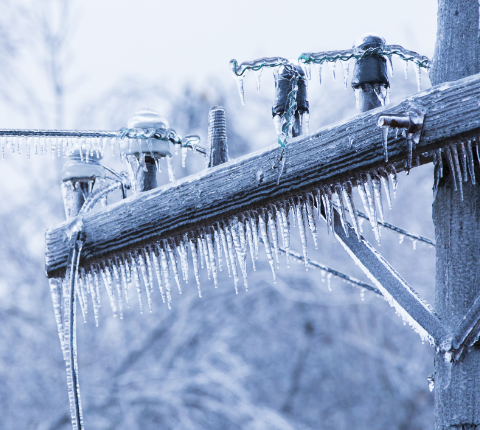STORM READY HARDWARE
With more extreme weather events, there are more instances of failures of the electrical grid. Hardware failures cause high repair costs, system security issues, equipment damage, injuries, and loss of customer confidence. SLACAN Industries pole line hardware is storm ready, engineered and built for the last 40 years with Charpy-rated toughness to meet the challenges of severe weather.


ENVIRONMENTAL IMPACTS ON RAW MATERIALS
All ferrous materials exhibit a change from ductile to brittle behaviour as the temperature drops. A brittle material is more likely to fracture during shock loads from weather conditions such as ice drop, wind gust, tree contact, etc. Stress concentration from an undetected defect or a stress riser more easily propagates through a brittle material than a ductile one. Brittle fracture is characterized by sudden failure at loads below the yield load with no deformation of the part and a crystalline appearance to the fracture surface.
There are many factors that affect the transition from ductile to brittle behaviour of a material: material chemistry, alloying, refining, processing, heat treatment and microstructure.
CHARPY-TESTED HARDWARE
SLACAN’s specialized manufacturing process keeps the material more ductile at lower operating temperatures. That capability is gauged by a Charpy Impact Test, which measures the energy needed to fracture a standard specimen at specific temperature.
Having good low-temperature ductility is an important property particularly on transmission products that require a high level of reliability. The ASTM E23 details the Charpy V-notch impact test method for determining whether a material is ductile or brittle. This test gives a relative measure of the energy needed to fracture a standard specimen at a particular temperature. Since steels exhibit a sudden change from ductile to brittle behaviour as the temperature decreases, this test should be conducted at the lowest service temperature expected, to ensure the material is still in the ductile range at the lowest temperature the hardware is expected to see.

Charpy V-notch testing in our state-of-the-art
quality control lab.
CHARPY IMPACT TEST
The test involves preparing a standard size sample from the part, with a specific V notch in it, chilling to the appropriate temperature, and placing it in a fixture so a pendulum strikes the sample, measuring how much energy it takes to fracture the part. The more energy it takes, the more ductile the material.
The Canadian Standards Association (CSA) standard C83 for Pole Line Hardware requires this test for transmission hardware and as an option for distribution hardware. They have set 3 levels for Charpy impact to be selected based on expected service temperatures as follows:
- Charpy Level 1 is the default minimum requirement of 20 Joules @ - 20C (15 ft-lbs @ 0F)
- Charpy Level 1.5 is 27 Joules @ -30C (20 ft-lbs @ -22F)
- Charpy Level 2 is 50% of the fracture face is ductile @ -45C (-50F)
As most areas of Canada experience temperatures as low as -30C Slacan has adopted a minimum Charpy level 1.5 for all transmission products.
Slacan also manufactures transmission products to Charpy Level 2, which we denote with the suffix “LPS”
FASTENERS MUST ALSO MEET CHARPY
It is of little use to make the fitting with Charpy impacts if the attaching fastener does not have the same ductility.
In order to ensure that both the hardware fitting and it’s attaching fastener both meet this requirement, Slacan makes our own fasteners from alloy steels that meet the mechanical properties of the grade but also have Charpy impacts.

CHARPY IMPACT COMPARISON
The photos show the difference in appearance of the fracture surface. The ductile iron is very crystalline and as you move right, the more ductile the material the more elongation and tearing of the surface. The ductile iron has a very brittle appearance, the 1040 is commonly used for forged hardware and grade 5 fasteners, but is marginal for ductility. The third one is Slacan’s material used for transmission hardware, while the last one is Slacan’s custom material Charpy 2, with the test temperature being at -50F, and it has higher impact values than any other, even at the lower temperature.
Slacan performs Charpy Impact testing on each production order to ensure the processing and heat treatment have been effective. In addition, Slacan inspects all transmission forging orders for surface defects using government certified MPI (Magnetic Particle Inspection) inspectors, to detect initiation points for cracks leading to fatigue or brittle fractures.
Fractured samples from some commonly used materials for pole line hardware.


